
Narasimhavarman I, also known as Narasimhavarman Mahamalla, reigned as a prominent Pallava king from 630 to 668 CE. His rule significantly impacted South Indian history, marked by architectural innovation and cultural flourishment. He is renowned for establishing the port city of Mahabalipuram (Mamallapuram), a vital center for trade and religion in Tamil Nadu, India.
Early Life and Rise to Power
Narasimhavarman I belonged to the illustrious Pallava dynasty, known for its patronage of art, architecture, and literature. He inherited the throne upon his father, Mahendravarman I’s, demise. His military triumphs, including the conquest of Vatapi and the formation of strategic alliances, solidified Pallava authority and broadened their influence across South India.
The Founding of Mahabalipuram
Narasimhavarman I envisioned Mahabalipuram as a thriving port city. Its strategic coastal location proved ideal for trade, facilitating maritime commerce with Southeast Asia. He nurtured Mahabalipuram into a vibrant cultural and economic center, fostering the growth of arts and crafts.
Architectural Wonders of Mahabalipuram
Mahabalipuram flourished architecturally under Narasimhavarman I’s reign. The city’s renowned rock-cut temples, dating back to the 7th and 8th centuries CE, exemplify Dravidian architecture with distinctive designs. Masterpieces like the Shore Temple, Pancha Rathas (Five Chariots), the Pancha Pandava Cave Temple, the Ganesha Ratha Temple, and the Karukathamman Temple showcase intricate rock-cutting techniques and artistic themes in their sculptures. These structures are part of the UNESCO World Heritage Site, reflecting the rich historical and architectural heritage of the Pallava dynasty.
Cultural and Religious Significance
The rock-cut temples held profound cultural and religious importance for both locals and visitors. They served as powerful mediums for promoting Hinduism and Shaivism through artistic depictions of deities and mythological narratives. These sacred spaces hosted religious rituals and community gatherings, strengthening cultural unity.
The Enduring Legacy of Narasimhavarman I
Narasimhavarman I’s contributions to South Indian history remain indelible. His architectural innovations influenced subsequent Pallava rulers and their projects. Mahabalipuram stands as a UNESCO World Heritage Site and a major tourist destination. His vision for Mahabalipuram has left an enduring mark on Indian cultural heritage.
Poojn.in: Enhancing Your Spiritual Journey
Poojn.in, India’s largest Dashakarma Bhandar, offers a wide selection of puja items to enrich your connection with Mahabalipuram’s heritage and Lord Vishnu worship. As you explore these magnificent temples, enhance your spiritual experience with authentic puja supplies:
- Pure Copper Vessels: Traditional containers for holy water and abhishekam rituals, essential for maintaining the sanctity of traditional worship practices.
- Brass Bells: Sacred instruments used in temple worship, adding a resonant dimension to your devotional experience.
- Incense and Dhoop: Premium quality aromatic offerings for temple visits, creating a sacred atmosphere.
- Cotton Wicks: Essential for lighting traditional temple lamps, symbolizing the illumination of knowledge and devotion.
- Devotional Items: Kumkum, turmeric, and other essential offerings, completing your puja rituals with authenticity.
Visit www.poojn.in to acquire genuine puja items that honor the ancient temple traditions. Our products are carefully chosen to adhere to traditional specifications and religious requirements, ensuring the sanctity of your worship practices, much like those practiced during the Pallava period.
Trust Poojn.in to provide authentic puja materials for both temple visits and home worship, celebrating the architectural and spiritual legacy of Mahabalipuram’s temples. Shop Now at Poojn.in.
Conclusion
Narasimhavarman I’s reign represents a golden age for the Pallava dynasty, reflecting his vision and leadership. His establishment of Mahabalipuram as a hub of trade, culture, and religion has left an enduring legacy. The rock-cut temples stand as testaments to his architectural brilliance and devotion. Mahabalipuram continues to inspire awe and reverence, a timeless reminder of the Pallavas’ rich heritage. Narasimhavarman I’s contributions ensure his enduring recognition, and his architectural marvels will be admired for generations to come.
Original Athizay Stone Shiva Lingam and Nandi Set
Radha Krishna Bigraha


